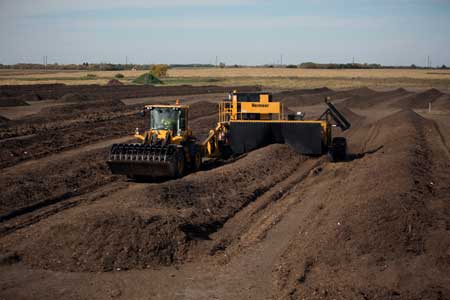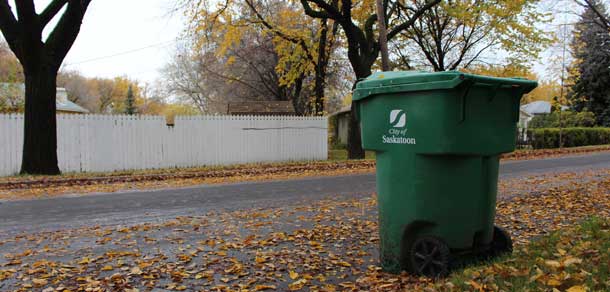Regina and Saskatoon compete in many ways, but there is one dubious distinction they share: Saskatchewan residents produce more waste per capita than any other province.
According to Michelle Jelinski, P.Eng., Senior Project Management Engineer at the City of Saskatoon’s Water & Waste Stream Division, the reasons for this are largely cultural ones.
“In Saskatchewan, we have always had the luxury of lots of land and a low population density. Consequently, building and running landfills has, to this point, been cheap and easy. Saskatchewan has one of the highest per capita number of landfills in North America. So, people have developed a feeling of entitlement about waste disposal. At the City, we often hear people complain, ‘why do I have to pay $15 for tipping fees when I only had to pay $2 back in my hometown?” says Jelinski.
As well, Jelinski notes, because of this luxury of space Saskatchewan cities are in some cases decades behind other jurisdictions in tackling the challenge of waste diversion.
“But in a way that’s also an advantage. It gives us the opportunity to gather a wealth of information about best practices and lessons learned from other cities,” she says.
Both cities have set aggressive targets to improve their waste diversion rates. But getting there won’t be easy.
A Breed Apart
The task of reducing waste in the major cities is a monumental engineering task that requires a special breed of professionals. While waste management may seem unglamorous, those in the industry speak of it with passion and excitement.
“I was drawn to this field by the diversity of engineering work involved,” says Greg Kuntz, P.Eng., Manager of Engineering Services for the City of Regina. “Almost every field of engineering is involved in waste management. Building and maintaining landfills is, essentially, a civil engineering task. There are elements of chemical engineering in examining the nature and decomposition of the waste. And, of course, there are the multi-faceted aspects of environmental engineering involved.”
To Jelinski, the waste management field is a special calling.
“The people drawn to this field are people who want to make a difference, who want to make the world a better place. Waste is something that affects everyone – we all contribute to it. Finding ways to manage waste that are more sustainable and safer for the environment– that’s a challenge people in our department find very rewarding,” she says.
Sorting Out the Problem
 Both cities, at around the same time in the early years of this decade, undertook studies to examine how they could manage waste better.
Both cities, at around the same time in the early years of this decade, undertook studies to examine how they could manage waste better.
“In Regina, what we found is that not much had changed over the decades. The way we were handling waste in 2012 was not significantly different from the way we did it in 1992. That wasn’t sustainable. The landfill was filling up too fast and we didn’t have good control over how we were managing the landfill site. We needed to look at best practices and figure out what would work for Regina,” says Lisa Legault, Director of Solid Waste for the City of Regina.
The two cities both set steep goals for waste reduction. Saskatoon aims to reduce its waste sent to landfill by 70 per cent (compared to 2013 levels) by 2023. Regina is shooting for a reduction of 65 per cent (compared to 2011 levels) by 2020.
The first step – in some ways the easiest and most obvious one – was to implement curbside residential recycling programs. Blue bins soon became as ubiquitous in Saskatoon and Regina as in other North American centres. Both cities also followed up the program with aggressive public education and promotion efforts.
A Big Gap to Close
For all of the public attention given to recycling, it has proven to be just a baby step towards the cities’ larger goals. Roughly eight years down the road, both cities have seen their waste diversion rates hover stubbornly around the 20 per cent mark. In contrast, larger centres like Toronto and Vancouver have already exceeded the 60 per cent diversion rate.
How will Saskatchewan cities close the gap?
“In both cities, we went through exercises in waste characterization – looking at samples of what people were actually putting in their garbage bins. For a typical single-family residential household, only about 16 per cent of the material in the bin is really garbage. Roughly 58 per cent is organic waste. If we can reclaim that, through ‘green bins’ and composting, that will go a long way to helping us achieve our goals,” Jelinski says.
Both city solid waste departments now have proposals before their respective city councils to examine organic waste programs.
“There are many ways we could end up going with such a program – anywhere from simple yard waste collection to scrape-your-plate waste food composting. Council is eager to hear and consider our proposals,” Legault says.
Saskatoon, likewise, is in the midst of drawing up organics proposals that will go before Saskatoon City Council in the fall.
Turning Trash into Gold
In addition to recycling and organics, the cities’ waste management departments also look for ways to find other uses for waste.
“My view is that we need to approach waste as a resource rather than as a problem. Can we use this resource in positive ways instead of just piling it up?” says Kuntz.
Both cities have implemented landfill gas energy systems, using the methane gas produced by decomposing waste to produce power. Each station produces enough power to supply over 1,000 homes and has the emissions reduction equivalent of up to 8,000 cars.
Regina and Saskatoon also make efforts to reclaim building materials from waste.
“Around construction and demolition season, we see lots of old lumber, concrete, rebar and the like going to the landfill. Those are valuable materials that should be put to another use,” Jelinski says.
Last year, Regina undertook a particularly massive and historically notable demolition reclamation initiative. After the old Mosaic Stadium (aka Taylor Field) was demolished, the city auctioned off nearly every scrap of it – roughly 29,000 tonnes – thereby keeping approximately 99 per cent of the demolished materials from going to landfill.
The China Connection
One factor that has proven to be a setback for waste diversion around North America is the strict new set of purity standards for recyclable materials under China’s National Sword program. Since China has, to date been the world’s largest buyer of recyclables, National Sword has cities and recycling companies scrambling to either find new markets or adapt to the stringent new rules.
For more on the effects of the National Sword program, read “Swords, Cow Heads and Miracle Glass” in this issue of The Professional Edge
.
Don’t Forget the Other Two ‘R’s
While recycling is important, Kuntz and Jelinski agree that it is far from the whole solution.
“The whole expression is ‘Reduce, Reuse, Recycle’. People often forget about those other two ‘ R’s. The best way to deal with waste is not to produce waste in the first place. All of us can contribute to that, both individuals and businesses, by being more mindful of what and how much we throw away. We also work with various levels of government and the Saskatchewan Waste Reduction Council in an effort to reduce excess packaging for products,” Kuntz says.
“This is an area where everyone needs to get involved and be informed. Even simple things like selling items on Kijiji or holding garage sales can help. Instead of taking the easy way out by automatically throwing something out, try to give some thought about what other use it might have,” Jelinski adds.
